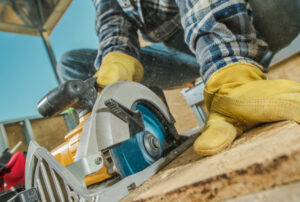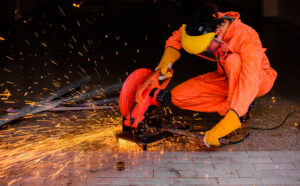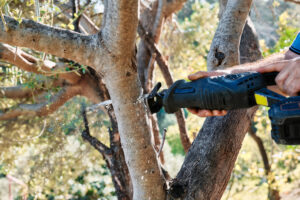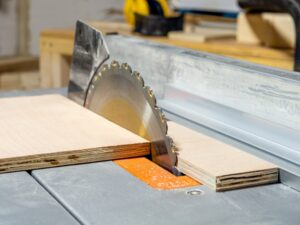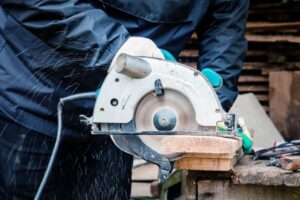
When it comes to operating a bandsaw, safety should always be a top priority. The risk of hand injuries can be significantly reduced by implementing proper safety measures.
In this article, I will provide you with essential tips and guidelines to prevent hand injuries and maintain a safe working environment while using a bandsaw. So, let’s dive in and explore the best practices for bandsaw safety.
Key Takeaways:
- Having a solid safety system in place is crucial for bandsaw safety.
- Proper personal protective equipment (PPE) is essential to protect against hand injuries.
- Sharp and properly tensioned blades are vital for safe bandsaw operation.
- Using safety features like cameras or infrared technology enhances bandsaw safety.
- Implementing safety management software allows for effective reporting and analysis.
Importance of Personal Protective Equipment (PPE) when operating bandsaws
Personal protective equipment (PPE) is a crucial aspect of bandsaw safety. It serves as the last line of defence against potential injuries. When operating a bandsaw, it is important to wear safety glasses or goggles to protect the eyes from small particles and debris. Hearing protection, such as earmuffs or earplugs, should be used to prevent hearing damage due to high noise levels. Respiratory protection, like dust masks, may be necessary when cutting materials that generate harmful dust.
By wearing the right PPE, operators can significantly reduce the risk of hand injuries and other potential hazards. Safety glasses or goggles shield the eyes from flying debris, wood chips, or metal shards that may be produced during cutting operations. Hearing protection prevents long-term hearing damage caused by prolonged exposure to loud noises generated by the bandsaw’s motor and cutting action. Dust masks or respirators protect against inhaling harmful dust particles, ensuring the operator’s respiratory well-being.
Suggested PPE for bandsaw operators
- Safety glasses or goggles
- Hearing protection (earmuffs or earplugs)
- Respiratory protection (dust masks or respirators)
- Cut-resistant gloves
- Steel-toed safety boots
- Protective clothing (such as long-sleeved shirts and pants)
| PPE | Function | Benefits |
|---|---|---|
| Safety glasses or goggles | Protect the eyes from small particles and debris | Prevent eye injuries and maintain clear vision |
| Hearing protection | Prevent hearing damage due to high noise levels | Preserve long-term hearing health |
| Respiratory protection | Protect against inhaling harmful dust particles | Preserve respiratory well-being |
| Cut-resistant gloves | Provide hand protection from blade contact | Reduce the risk of hand injuries |
| Steel-toed safety boots | Protect feet from heavy objects or falling debris | Minimise foot injuries |
| Protective clothing | Cover and shield the body from potential hazards | Ensure overall body protection |
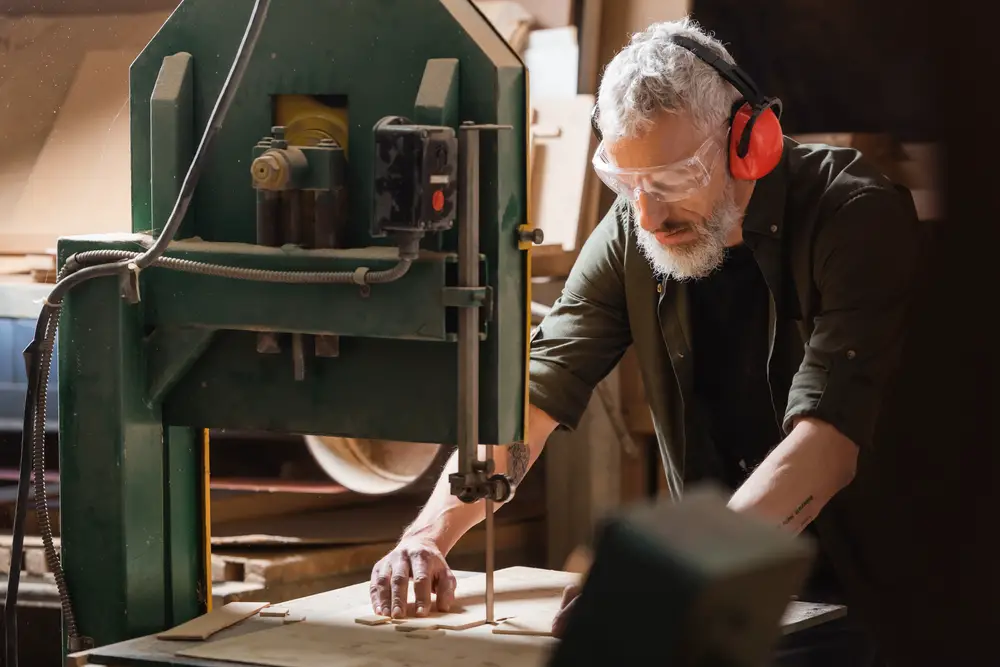
Understanding the risks associated with bandsaw use
Operating a bandsaw machine offers versatility and precision, but it also comes with potential hazards that must be understood to ensure safe operation. By recognizing the risks associated with bandsaw use, operators can take appropriate precautions to reduce the likelihood of accidents and injuries.
Blade contact
One of the primary risks when using a bandsaw is blade contact, which can lead to severe lacerations or even amputations. The rapidly moving blade poses a significant danger if proper precautions are not taken. Operators must be vigilant in maintaining a safe distance from the blade and be cautious when handling workpieces to avoid accidental contact.
Improper body positioning
Another risk factor to consider is improper body positioning, which can result in a loss of control over the bandsaw machine. Operators must maintain correct posture and stance while operating the machine to minimise the risk of accidents. By adopting proper body positioning and using appropriate safety accessories, such as push sticks and feather boards, operators can enhance their control and reduce the likelihood of injuries.
Inadequate speed adjustments
Adjusting the speed of the bandsaw blade based on the material being cut is essential for safe operation. Using an improper speed can lead to kickbacks, material jams, and other accidents. Operators must carefully select the appropriate speed setting, considering the type and thickness of the material, to ensure smooth and safe cutting.
| Risk | Description |
|---|---|
| Blade contact | Potential for severe lacerations or amputations if there is accidental contact with the rapidly moving blade. |
| Improper body positioning | Loss of control over the machine due to incorrect posture or stance increases the risk of accidents. |
| Inadequate speed adjustments | Using an inappropriate speed setting for the material being cut can lead to kickbacks, jams, and other accidents. |
Pre-operational Safety Checks for Bandsaw Machines
Before using a bandsaw machine, it is crucial to conduct pre-operational safety checks to ensure the machine is safe and in proper working condition. By following a systematic approach, operators can identify and address any potential hazards or issues that may compromise safety.
Table: Pre-operational Safety Checks
| Check | Procedure |
|---|---|
| Inspect for Visible Damages | Ensure that the bandsaw machine does not have any visible damages, such as broken parts or loose components. Repair or replace any damaged parts before using the machine. |
| Check Blade Tension and Tracking | Verify that the bandsaw blade is properly tensioned and aligned. Adjust the tension and tracking if necessary to ensure smooth and accurate cutting. |
| Adjust Blade Guards | Ensure that the blade guards are properly positioned and in good condition. The guards play a crucial role in preventing accidental contact with the blade during operation. |
| Clean and Well-lit Work Area | Clear the work area of any debris or obstacles that may pose a tripping or slipping hazard. Additionally, ensure that the work area is well-lit to enhance visibility during cutting operations. |
Remember, taking the time to conduct pre-operational safety checks is a proactive measure that demonstrates a commitment to maintaining a safe working environment. It is essential for both the operators’ well-being and the overall success of the bandsaw operations.
Safe operating procedures for bandsaw machines
When operating bandsaw machines, it is essential to follow safe procedures to minimize the risk of accidents and promote a culture of safety. By maintaining the correct body position, adjusting the machine’s speed based on the material being cut, and utilizing safety accessories, operators can significantly reduce the likelihood of injuries.
Proper Body Position
To ensure safe operation, it is important to maintain a correct body position while using a bandsaw machine. This involves standing with feet shoulder-width apart and keeping a balanced stance. By positioning oneself in this manner, operators can maintain stability and control over the machine, minimizing the risk of accidents.
Adjusting Speed
Adjusting the speed of the bandsaw machine according to the material being cut is crucial for safe operation. Different materials require different cutting speeds to ensure efficiency and reduce the risk of kickbacks. Operators should consult the manufacturer’s guidelines or the operator’s manual to determine the appropriate speed settings for each specific material.
Utilising Safety Accessories
Using safety accessories like push sticks and feather boards can provide an additional layer of protection when operating a bandsaw machine. Push sticks allow operators to guide the material through the machine while keeping their hands at a safe distance from the blade, reducing the risk of hand injuries. Feather boards help to keep the material securely in place, preventing it from shifting or moving unexpectedly during the cutting process.
Importance of Proper Training for Bandsaw Operators
Proper training plays a crucial role in ensuring the safety of bandsaw operators. It equips them with the necessary knowledge and skills to recognize and mitigate potential hazards, promoting a culture of safety in the workplace. With the right training, operators can assess job activity-level risks, identify potential dangers, and follow the appropriate safety procedures to minimize the risk of accidents.
During training, operators learn about the various risks associated with bandsaw use. They understand the importance of maintaining proper body position, keeping a safe distance from the blade, and using safety accessories like push sticks and feather boards. Operators also gain valuable insights into the specific guidelines and safety precautions outlined in the bandsaw machine’s operator’s manual, allowing them to operate the machine safely and effectively.
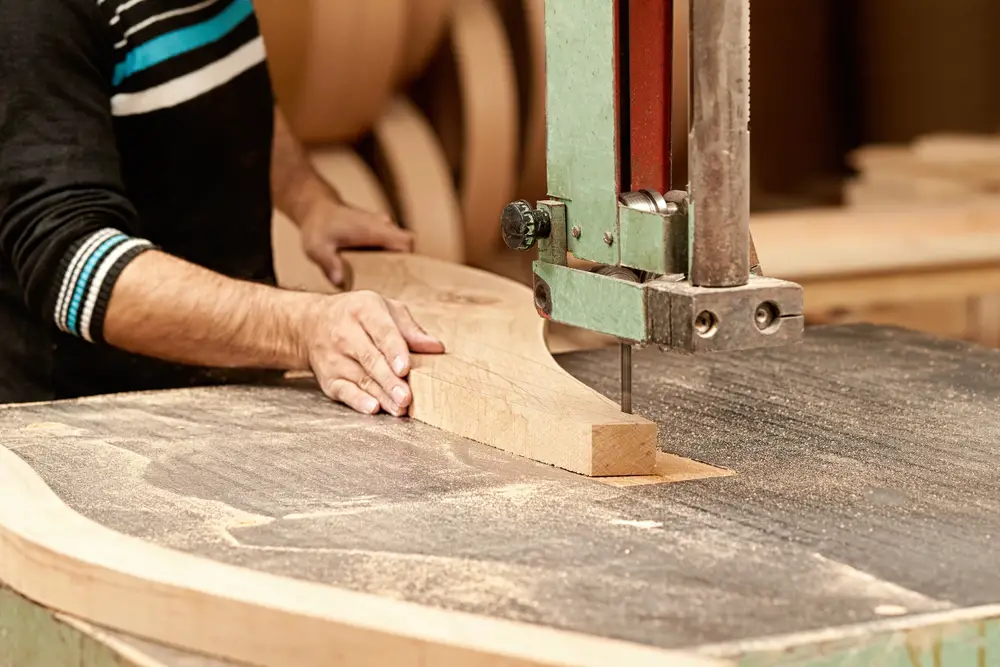
Benefits of Proper Training for Bandsaw Operators
Proper training not only enhances the safety of bandsaw operators but also offers several other benefits. Firstly, it boosts productivity by improving the efficiency of bandsaw operations. With a thorough understanding of safe operating procedures, operators can work confidently and effectively, minimizing downtime caused by accidents or injuries.
Secondly, training fosters a positive work environment by instilling a culture of safety among operators. When employees feel valued and supported through training programs, they are more likely to prioritize safety and look out for one another. This collaborative approach contributes to a harmonious and productive workplace.
| Key Benefits of Proper Training: |
|---|
| Enhanced safety for bandsaw operators |
| Increased productivity and efficiency |
| Promotion of a positive work environment |
| Improved employee satisfaction and retention |
The role of safety management software in bandsaw safety
Managing safety in the context of bandsaw operations requires a comprehensive and proactive approach. Safety management software plays a vital role in ensuring long-term bandsaw safety by providing organizations with the tools they need to effectively manage and monitor safety performance. With safety management software, organizations can create a culture of safety, improve safety systems, and reduce the risk of accidents.
One of the key benefits of safety management software is its ability to provide detailed safety reporting. By capturing and analyzing data related to safety incidents, near misses, and hazards, organizations can identify patterns or trends in injuries and take proactive measures to prevent future incidents. Safety reporting allows for a thorough understanding of the safety performance within an organization and facilitates informed decision-making.
In addition to safety reporting, safety management software also enables organizations to track and manage safety documentation. It provides a centralized platform for storing safety policies, procedures, and training materials, making them easily accessible to bandsaw operators. This ensures that operators have access to the most up-to-date information and can follow the necessary safety protocols.
| Benefits of Safety Management Software in Bandsaw Safety |
|---|
| Comprehensive safety reporting to identify patterns and trends |
| Centralised storage of safety documentation for easy access |
| Facilitation of communication and collaboration among operators |
| Promotion of a culture of safety |
Conclusion
In conclusion, prioritising bandsaw safety is paramount in preventing hand injuries. By implementing a solid safety system, providing appropriate personal protective equipment (PPE), conducting pre-operational safety checks, following safe operating procedures, offering comprehensive training, and utilising safety management software, organisations can significantly reduce the risk of accidents.
Creating a safer working environment and promoting a culture of safety is crucial for the well-being of operators and the prevention of hand injuries. By taking proactive measures and making safety a top priority, organisations can ensure the protection of their employees and achieve a more productive and accident-free workplace.
Remember, bandsaw safety is a collective responsibility. Let’s work together to prioritise safety and prevent hand injuries. By doing so, we can ensure a safer and more secure work environment for all bandsaw operators.
FAQ
What are some top tips to improve safety with bandsaws?
Some top tips to improve safety with bandsaws include having a solid safety system in place, providing proper personal protective equipment (PPE), ensuring sharp and properly tensioned blades, using safety features like cameras or infrared technology, and implementing safety management software for reporting and analysis.
Why is personal protective equipment (PPE) important when operating bandsaws?
Personal protective equipment (PPE) is crucial for bandsaw safety as it serves as the last line of defense against potential injuries. Safety glasses or goggles protect the eyes from small particles and debris, hearing protection prevents hearing damage due to high noise levels, and respiratory protection like dust masks may be necessary when cutting materials that generate harmful dust. Prioritizing the use of appropriate PPE ensures safety while operating a bandsaw.
What risks are associated with bandsaw use?
Some risks associated with bandsaw use include blade contact leading to lacerations or amputations, improper body positioning causing loss of control, and inadequate speed adjustments based on the material being cut. Understanding these risks and implementing proper safety procedures can significantly reduce the likelihood of accidents.
What are pre-operational safety checks for bandsaw machines?
Pre-operational safety checks for bandsaw machines involve inspecting the machine for visible damages, checking blade tension and tracking, adjusting blade guards, and ensuring a clean and well-lit work area. These checks ensure that the machine is in a safe and proper condition for use, helping operators identify potential hazards and mitigate the risk of accidents.
What are some safe operating procedures for bandsaw machines?
Safe operating procedures for bandsaw machines include maintaining correct body position, keeping a safe distance from the blade, adjusting speed based on the material, and using safety accessories like push sticks and feather boards. Operators should also familiarize themselves with the specific guidelines and safety precautions outlined in the operator’s manual for their bandsaw machine. Following these procedures significantly reduces the risk of injuries.
Why is proper training important for bandsaw operators?
Proper training is essential for bandsaw operators to ensure their safety and the safety of others. Training should cover the recognition of hazards associated with bandsaw use, understanding of safety procedures, and the proper use of tools and equipment. Operators should be able to assess job activity-level hazards, identify potential risks, and follow the necessary safety precautions. Comprehensive training helps prevent accidents and promotes a culture of safety in the workplace.
What is the role of safety management software in bandsaw safety?
Safety management software plays a crucial role in long-term bandsaw safety. It allows for comprehensive reporting and analysis of safety performance, interactions between staff, and identification of patterns or trends in injuries. With safety management software, organizations can create meaningful reports that help change behavior, improve safety systems, and enhance training programs. The data obtained from such software enables informed decision-making and proactive measures to prevent injuries.
- Drill Battery Maintenance: Essential Tips for Cordless Drill Battery Care - February 5, 2024
- Troubleshooting Drill Issues - February 5, 2024
- Quick Drilling Techniques - February 2, 2024


